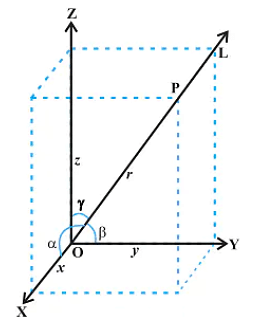The equation of the line joining the points $(-3,4,11)$ and $(1,-2,7)$ is
- $\frac{x+3}{2}=\frac{y-4}{3}=\frac{z-11}{4}$
- $\frac{x+3}{-2}=\frac{y-4}{3}=\frac{z-11}{2}$
- $\frac{x+3}{-2}=\frac{y+4}{3}=\frac{z+11}{4}$
- $\frac{x+3}{2}=\frac{y+4}{-3}=\frac{z+11}{2}$
The Correct Option is B
Solution and Explanation
To find the equation of the line passing through the points \((-3, 4, 11)\) and \((1, -2, 7)\), we use the vector form of a line in three-dimensional space. The equation for a line passing through the point \((x_1, y_1, z_1)\) with direction ratios \((a, b, c)\) is given by:
\(\frac{x-x_1}{a}=\frac{y-y_1}{b}=\frac{z-z_1}{c}\)
First, let's determine the direction ratios by subtracting the coordinates of the given points:
- Direction ratio for \(x\): \(1 - (-3) = 4\)
- Direction ratio for \(y\): \(-2 - 4 = -6\)
- Direction ratio for \(z\): \(7 - 11 = -4\)
Thus, the direction ratios are \((4, -6, -4)\). However, these ratios can be simplified by dividing each by 2:
Resulting simplified direction ratios are \((2, -3, -2)\).
Now, substitute these values into the line equation form using the point \((-3, 4, 11)\):
\(\frac{x+3}{2}=\frac{y-4}{-3}=\frac{z-11}{-2}\)
To compare with the given options, we observe that by multiplying each term by -1, we get the correct formation:
\(\frac{x+3}{-2}=\frac{y-4}{3}=\frac{z-11}{2}\)
This matches the given correct option: \(\frac{x+3}{-2}=\frac{y-4}{3}=\frac{z-11}{2}\).
Therefore, the correct option is:
\(\frac{x+3}{-2}=\frac{y-4}{3}=\frac{z-11}{2}\)
Top Questions on Three Dimensional Geometry
- If m:n is the ratio in which the point $\left(\frac{8}{5}, \frac{1}{5}, \frac{8}{5}\right)$ divides the line segment joining the points (2,p,2) and (p,-2,p) where p is an integer then $\frac{3m+n}{3n}=$
- TS EAMCET - 2025
- Mathematics
- Three Dimensional Geometry
- If A(2,1,-1), B(6,-3,2), C(-3,12,4) are the vertices of a triangle ABC and the equation of the plane containing the triangle ABC is $53x+by+cz+d=0$, then $\frac{d}{b+c}=$
- TS EAMCET - 2025
- Mathematics
- Three Dimensional Geometry
- If $(\alpha, \beta, \gamma)$ is the foot of the perpendicular drawn from a point $(-1,2,-1)$ to the line joining the points $(2,-1,1)$ and $(1,1,-2)$, then $\alpha+\beta+\gamma=$
- TS EAMCET - 2025
- Mathematics
- Three Dimensional Geometry
- Let $\pi_1$ be the plane determined by the vectors $\hat{i}+\hat{j}, \hat{i}+\hat{k}$ and $\pi_2$ be the plane determined by the vectors $\hat{j}-\hat{k}, \hat{k}-\hat{i}$. Let $\vec{a}$ be a non-zero vector parallel to the line of intersection of the planes $\pi_1$ and $\pi_2$. If $\vec{b} = \hat{i}+\hat{j}-\hat{k}$ then the angle between the vectors $\vec{a}$ and $\vec{b}$ is
- TS EAMCET - 2025
- Mathematics
- Three Dimensional Geometry
Show that the following lines intersect. Also, find their point of intersection:
Line 1: \[ \frac{x - 1}{2} = \frac{y - 2}{3} = \frac{z - 3}{4} \]
Line 2: \[ \frac{x - 4}{5} = \frac{y - 1}{2} = z \]
- CBSE CLASS XII - 2025
- CBSE Compartment XII - 2025
- Mathematics
- Three Dimensional Geometry
Questions Asked in KCET exam
- If the number of terms in the binomial expansion of \((2x + 3)^n\) is 22, then the value of \(n\) is:
- KCET - 2025
- Binomial theorem
- A random experiment has five outcomes \(w_1, w_2, w_3, w_4, w_5\). The probabilities of the occurrence of the outcomes \(w_1, w_2, w_4, w_5\) are respectively \( \frac{1}{6}, a, b, \frac{1}{12} \) such that \(12a + 12b - 1 = 0\). Then the probabilities of occurrence of the outcome \(w_3\) is:
- KCET - 2025
- Probability
- If 'a' and 'b' are the order and degree respectively of the differentiable equation \[ \frac{d^2 y}{dx^2} + \left(\frac{dy}{dx}\right)^3 + x^4 = 0, \quad \text{then} \, a - b = \, \_ \_ \]
- KCET - 2025
- Differential equations
- Meera visits only one of the two temples A and B in her locality. Probability that she visits temple A is \( \frac{2}{5} \). If she visits temple A, the probability that she meets her friend is \( \frac{1}{3} \). The probability that she meets her friend, whereas it is \( \frac{2}{7} \) if she visits temple B. Meera met her friend at one of the two temples. The probability that she met her friend at temple B is:
- KCET - 2025
- Probability
In a practical examination, the following pedigree chart was given as a spotter for identification. The students identify the given pedigree chart as

- KCET - 2025
- Genetics
Concepts Used:
Three Dimensional Geometry
Mathematically, Geometry is one of the most important topics. The concepts of Geometry are derived w.r.t. the planes. So, Geometry is divided into three major categories based on its dimensions which are one-dimensional geometry, two-dimensional geometry, and three-dimensional geometry.
Direction Cosines and Direction Ratios of Line:
Consider a line L that is passing through the three-dimensional plane. Now, x,y and z are the axes of the plane and α,β, and γ are the three angles the line makes with these axes. These are commonly known as the direction angles of the plane. So, appropriately, we can say that cosα, cosβ, and cosγ are the direction cosines of the given line L.
